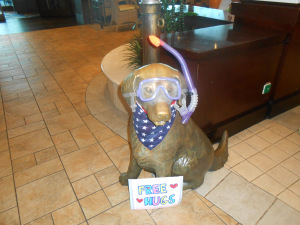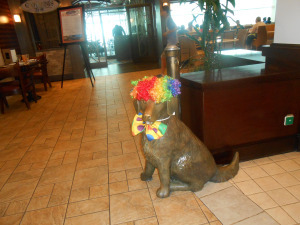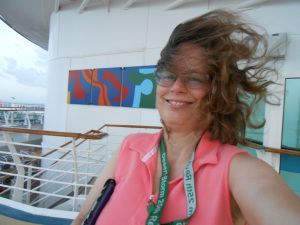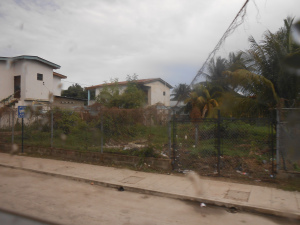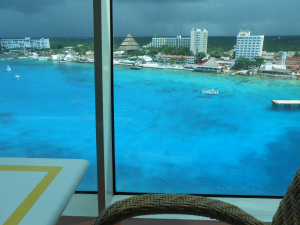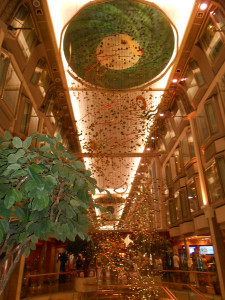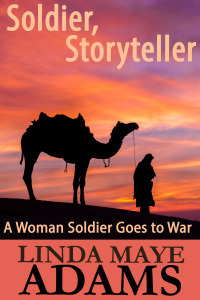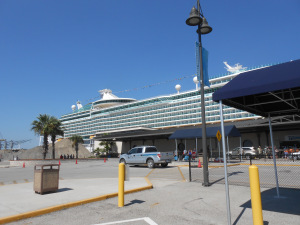Linda Maye Adams's Blog, page 92
November 12, 2015
Washington Wanderings: Planetside and Blanketside
Saturday morning I realized I needed to recharge the muse a little with a trip to see art. I started with picking the museum pretty much because I did want to do a transfer on Metro. If any of the lines are single-tracking due to maintenance, it becomes a big headache and a whole lot of people. So, when I saw that there looked to be a decent art exhibit by Kay Walkingstick at the National Museum of the American Indian, that was it. The exhibit actually opened that day.
Generally, I haven’t liked the NMAI. I went to the museum right after it opened its doors for the first time and found it visually noisy. Smithsonian had some criticisms for being politically correct, and the museum felt like they were trying to please everyone. They had tried to put in a section for all the of the tribes, and there were too many to do a decent job with it.
The second time I went, it was to see an exhibit by a Hawaiian artist that was a joint project with a local gallery. I was writing my Hawaii book Rogue God at the time, and I was intrigued in seeing contemporary Hawaiian art.
I got home tools like shovels and brooms.
So this was my third time at the museum. Fingers crossed!
It was raining out when I left. Not really hard, so I figured I could manage without the umbrella. The news made it sound like the rain would blow through. I hopped the Metro and got off at L’Enfant Plaza and back out into the rain. A short walk to the museum (thankfully!).
First stop inside was at the 4th Floor theater, mainly because there was a sign over the elevator that said something like “Start your visit in the theater.” The theater was kind of strange because it had three “screens.” The first was on an Indian blanket, and that was the primary screen. The second was on the “grandfather rock,” which was a polished globe in the floor. The third was on the ceiling, and it was sort of a planetarium screen.
I was sort of torn between planetside and blanketside, and ignored poor grandfather. Some aspects of the film reminded me of these Alaskan films that I saw in 5th or 5th grade. The films showed the Alaskans (who were also in the blanketside film) cutting freshly killed animals and eating the meat from the knife. The grade school films were actually quite bloody. We had a little bit of that here, but nothing like those school films.
Then the film wrapped and it was lunch time so I wandered off to the café to see what was there. This was, hands down, one of the best of the food restaurants in the Smithsonian (Air and Space is one of the worst—it’s a MacDonald’s so there are very few options; Natural History Museum is also pretty poor because they imply healthy food, and healthy means free range).
I picked Indian Tacos, which consisted of Buffalo Chili (beans and sauce, not buffalo meat); lettuce, tomatoes, bell pepper; cheddar cheese; and fry bread. I’d read about fry bread in the Ellah Clah books, so it was on my list to try it. The bread was round and kind of flat, but thicker than a tortilla and puffy. Inside it was pleasurably soft. The taco parts were spread on top of it, so I may have to make a trip back for fry bread by itself. But it was very good.
And I was amazed that the people in front of me just ordered hamburgers. Seriously? You can’t try something new out?
Up to the third floor for the Kay Walkingstick exhibit. The museum guard warned me that an alarm would sound if I got within two feet of the paintings. That’s probably in place because of the Gaughan incident a few years ago. There was a Gaughan exhibit at the National Art Gallery. It was his Tahiti paintings, so lots of nudes. A woman went nuts and tried to damage one of the paintings.
He also said the artist had been by the day before, and he was in awe of her. Pity! I wish I could have seen her. That would have been cool. I settled for a movie she filmed for the museum that was part of the exhibit.
The exhibit itself was very extensive (not like my previous experience with three pieces that consisted of tools). It covered 1970s all the way through today. I found the modern day landscapes just stunning. The colors and images were stunning. You can see the artworks on Walkingstick’s site. Each section has art that was in this exhibit. The section called “Works on Canvas & Wood” feature the landscapes that I really enjoyed.
After I finished wandering, it was time to go back outside. Yup! Still raining, and a bit harder. Really should have brought the umbrella!
Filed under: Culture, Thoughts, Travel Tagged: Art, Kay Walkingstick, National Museum of the American Indian, Paintings, Washington DC








November 9, 2015
A Call to Pens for Women Veterans
Someone on Twitter reported “How insulting” that I thought I was the only woman veteran writing, so I wanted to write about why I think that.
Especially with Veteran’s Day on Wednesday. There’s going to be a lot of people sending veteran photos over Facebook. Photos of men standing next to the Vietnam Memorial; men out on the battlefield; men holding rifles.
The default image of a soldier is a man. I’ll read a front page article on the Veteran’s Administration or something else on the military. The newspaper will have interviews with three soldiers, and it’s all men. Sure, they’ll be an article about women once in a while, and it’s like an afterthought. Oh yeah. We have to write about the women, too.
The books are like that, too.
There will be a book on women who served, like the one I found when I returned home from Desert Storm, and then a bunch of books about the men. There are women in those books, but it’s the wives writing them, or the daughters and granddaughters.
When I’ve been published in some of these collections, I’ve often been the only woman veteran. The exception was Red, White & True. That book was edited by a woman veteran who had previously published a book and had one other woman veteran besides me. Still not a whole lot.
It’s hard finding the stories of the women soldiers, about their experiences.
So much so that the women veterans on a Facebook page I’m on (all women; all services) complained that there was no representation for the women veterans.
Is there bias?
Yes. That’s pretty clear. But everyone tends to point fingers at only one party, and the women are also responsible.
Let’s start with the fact that writing well enough for publication is a darned hard skill to learn. It’s not a matter of just having what we think is a best selling story, putting the words on paper, and magic happens. Though most people think that.
Add to that a lot of the veteran’s calls are non-paying. In many cases, what gets into the non-paying is not going to be very good quality. Any veteran who is writing professionally is going to want to get paid for their time and effort so they steer clear.
The second problem is that there’s a high likelihood that the publisher of this book is going to be inexperienced. In one of the early non-paying books I was in, they accepted everyone who submitted and probably shouldn’t have (and I was still the only woman veteran writing in that!).
What’s wrong with that? First, if the pieces aren’t screened for a specific theme or quality, readers are probably not going to buy the book. There might be a few, and family will certainly buy it, but it’s not going to get a lot of visibility.
But also, if the publisher doesn’t know what they’re doing, they can tend to be people wanting to either help writers, or veterans. That sounds like a good thing, and it’s not because they’re focusing on helping the writers, not on giving the readers what they want to read. If the book makes it to publication, it’s probably not going to be read by very many.
Assuming the book doesn’t crash and burn before it gets to publication.
I was accepted for one book that was part of a fledgling small press. It was not a veteran’s call, but it had a topic that I could do a woman veteran story for. In this case the topic really lent itself to therapy. Meaning, everyone—including me—were writing these stories as therapy. I think the editor was doing it for that, too.
She got into a strange fight with the publisher over the title of the book versus what she had called a small business she started. The publisher thought the names were too similar. It was strange because no one would have thought of the business when seeing the title. In hindsight, I think the publisher suddenly realized they had a problem when they saw the book. They may have been imaging something different in the pitch; when they saw the book, they realized they were going to lose a lot of money on it.
Which goes to the third problem, and that has to do with the writer. I’m on a women’s writing board, and everyone seems to be doing a memoir. Writing about rape and abuse is a popular topic for a memoir (therapy, remember?). There’s a woman on the women’s veteran board who wants to write a book about her experiences with military sexual trauma.
We had front page news with the scandals about how the military was treating what happened to the women soldiers. How many publishers grabbed up stories about those personal experiences and rushed it to press to cash in on the publicity?
None. (Don’t believe me? Google it.)
It’s a not a topic readers want to read about beyond a news story. It’s too difficult of a topic to spend an entire book on. Every book has to be entertaining in some way, even if it’s exposing a scandal. But the reality is that there are some topics where it’s just plain a hard sell to the average reader.
Add to that probably a lot of women veterans are doing what the average writer does: This book is The Event. They put all their effort into writing this one book, or this one story. If it doesn’t get accepted by an agent, they turn to the free publications. If it gets published, it disappears because few are reading the poorer quality non-paying publications. If the publication folds, it disappears, too.
And if only a few women veterans are even trying to write about their experiences, that makes it easy for them to never be seen.
The answer is one story is not The Event, and it’s probably not what people want to hear: Write a lot of stories.
Early on, I did a story twice about visiting a Vietnam memorial for the first time after the war. Both those were published (non-paying publication though). I also did a Christmas in Desert Storm piece that got into the Washington Post. After Starcon, I wrote a non-fiction article about meeting William Windom (Star Trek), because it was really about two vets, one of whom was an actor. That one was also submitted to a non-paying market that folded. Since we had a dog during Desert Storm, I tried one for Dog Fancy and got a personal rejection for that one (a shame. That one was professional payment!).
I also ventured into fiction and poetry. I have poetry still in submission to an anthology on death. They did pay, but not a lot, which was why I wrote the poem, since it was lousy pay for a short story but great pay for a poem. I’m also thinking of writing for a paying call for poetry on fear. That doesn’t pay a lot, but if it doesn’t get accepted (and if does), I can use it to fill a future book of war fiction and poetry. I’m also thinking about military science fiction stories.
The best chances for women veteran’s voices to be heard is get our stories—as in more than one—everywhere.
Filed under: Military, Writing Tagged: Women Veterans








November 6, 2015
Desert Storm Reunion: Day 6 and 7 at sea
After we left Honduras, we were on our way back with two days at sea. We also got weather. The seas were heavier, so the ship would periodically lurch and sway. Nothing too bad mostly; every now and then, the ship would lurch in a way that made every one stop and go “Did you feel that?”
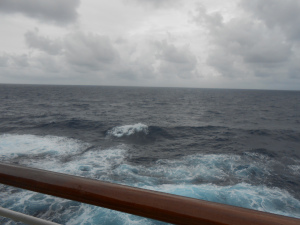
The water was like this all the way back.
One of the passengers also reported in the elevator that there had been an accident on the rock climbing wall. The lurching had caused a climber to swing away from wall and then slammed her into it, breaking her arm. Ouch!
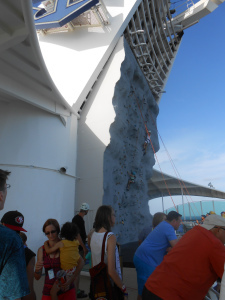
That’s the rock climbing wall. It was on the highest point of the ship.
Friday was the Desert Storm Memorial ceremony. The ship did not allow it to be listed in the Cruise Compass, so it was just attended by veterans. We gathered in the ship’s conference room for the ceremony and watched each other lean from side to side in unison during the National Anthem.
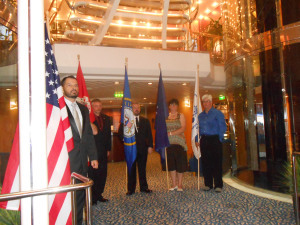
Displaying the “colors.”
After that, volunteers from the services read the names of the fallen aloud.
(I’m seated to the left of the lectern).
One of the women had about a 10 second comment (edited out of the video) before reading the names. That caused quite a stir that apparently turned rather nasty. Some of the comments afterward fussed along the lines that she had gone off script—it was such a strange reaction that I was wondering initially what they were talking about. After the cruise, it turned into a bigger spat (the speed of the internet made me miss most of it), but it seemed like the same thing when the women’s memorial was added to the Vietnam Memorial where the veterans devalued another veteran’s experience.
My opinion: War leaves a deep imprint, and those experiences are larger than life. So much so that if someone has different experiences, but also ones that left that same deep imprint, that one vet will say, “That’s not as bad as mine, so you have no right to complain (or get honored).” We were in the rear during the war, such as the rear was. I had a friend who had one of those experiences that left such a deep imprint that it destroyed her. Yet, a front line vet might very well devalue that because his own experiences also left such a deep imprint.
And all of this might come from the problem is that none of the veterans from any of the wars from Vietnam forward did any kind of bonding or healing on the return home. We just came back on a plane and were expected to resume normal activities. (For World War II, the veterans were sent back on a ship that took about a month.)
There were other Desert Storm events, but I attended an art auction with a couple of the vets. There was an auction on Friday and Saturday. Friday’s feature Thomas Kincaid. I also attended a panel session on his art, which was very interesting. You’ll never see his paintings the same way once you know this:
If you have one of his pieces, look for the signature. Somewhere near it is a number. That is the number of Ns hidden in the painting. Every time he thought of his wife, he added the first letter of her name to the painting. Of course, after we heard that, we were up in the art gallery checking out his paintings and trying to find Ns. The auction employees confessed that those N’s are darned hard to find.
Lila (she’s the one carrying the Air Force flag in the video) bought a wonderful metal work painting of two wine glasses coming together. Black background, crimson wine. Spectacular. She got some Thomas Kincaids, and between what she purchased and won from the raffles, it was 14 paintings. 14!
Other artists auctioned off:
Autumn Deforest. She’s only 14! I was sitting too far back, so it was hard to see how magnificent her works were until I got up close.
Peter Max. Stunning color to these paintings and way out of my price range. I think one of the paintings was going for $70,000.
Friday also had my final towel animal, which I found hanging from the ceiling. Incredible amount of detail, even in the face.
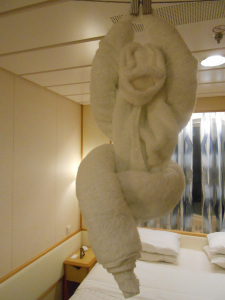
Coincidence that I went to the monkey park? Enlarge and check out the face!
And the dog got dressed up in scuba gear …
And then in bright colors.
Despite all the weather, we arrived right on time in Galveston on Sunday. I was glad to finally get back. I’d done enough cruising. Though I might think of another one again.
Filed under: Photos, Travel Tagged: Autumn Deforest, Cruising, Desert Storm Reunion, Peter Max, Thomas Kincaid








November 5, 2015
Desert Storm Reunion – Day 5 – Honduras
One of the things I noticed is that the ship ALWAYS arrived on time at each of the ports. I woke up on Thursday, looked out my window and could see the port.
By the way, if you’re wondering how I could keep track of each day while I was on the ship, it wasn’t hard. Every day the crew replaced a plate in the elevator with new one with the day. For Honduras, we were cautioned to make sure we were following ship time because Honduras was an hour behind.
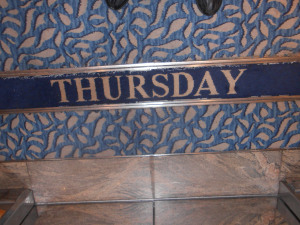
These were changed daily in the elevators.
Today, I had a trip out to Gumbalimba Park. Rick, one of the veterans, kept asking me if the Belize Zoo from the day before had the “bridge”—it was actually this park in Honduras.
The tour started at 11:00, so I checked out the stores on the dock.
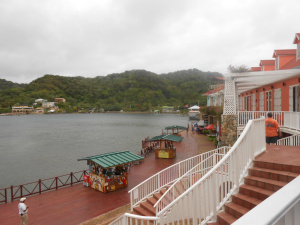
The stores on the port. I was actually trying to catch shots of people going down a zipline to that green shore in the background.
I bought some chocolate and also a painting. The artist was selling the paintings at a stand, and most of the works were typical tourist stuff: Beaches, turtles, dolphins. I was looking through stacks of paintings for the right one, though I couldn’t have explained what I was looking for. I found one, which was of a Honduras woman carrying a basket on her head. Close … maybe.
There was a man helping the artist, and he said, “A hard working woman.” He helped me with the stacks, and it was kind of weird because he wasn’t trying to get me to buy any of them. I pulled out another one, also a Honduras woman, similar to the first but different backdrop. Not quite right.
Then I hit the one, and that was it. I had my painting, and I was done.
It was curious because this couple came by at the same time, bought a painting and left. But after I paid for mine, the artist wanted a picture of me with him.
Dropped my painting off in my stateroom, and then it was time for the short excursion. The tour guides piled us on a bunch of buses. I was a solo traveler, and I could see where the guides were suddenly going, “Wait, we have to put this one person somewhere.” So they had me get into the front seat of one of the buses. It turned out to be a terrifying experience. The driver got us to the park in record time, but I kept thinking we were going to hit someone!
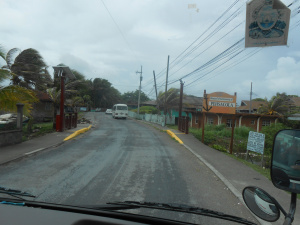
This was taken from the front seat of the tour bus.
The roads didn’t have any sidewalks, so people would be riding bikes in the street, or walking, and dogs would come out and watch the world, and everyone was so close to the bus. At once point, where there was a sidewalk, he drove on it. Interesting fact: They don’t have addresses in Honduras like we do. The houses are all painted bright colors to make the identifiable. So your mailing address might be “The blue house behind the rotting tree” in a particular city.
At the park, we gathered in our group. Then we were off to check out the park and get our safety briefing. For the macaws, we were warned not to have any ball caps with buttons. Apparently the liked to eat the buttons. For the monkeys, it was glasses. They really like glasses and will steal them off your face and try to put them on. Of course, the glasses won’t fit, so they’ll get mad and try to break them. If you try to take the glasses away from them, they’ll get aggressive and slap you.
Oh yeah.
First stop was The Bridge:
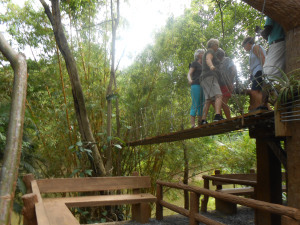
Sorry, but no way!
No, I didn’t cross it. I’m afraid of heights, and I knew I would have had problems with all the swaying. Only two other people opted for the “Chicken Bridge.”
At the other end was the Macaws. They are loud. There were two of them going at each other in case, just screaming.
We all posed with a green one that was a “military bird.” This one man had on a polo shirt with a button on a collar. The trainer set the bird on the opposite shoulder, and suddenly the bird snaked around behind his neck. Its beak went for the button and crunch! It was gone!
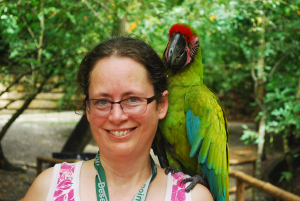
No button eating here!
Then it was off to the monkeys. The park had a trainer out there to make sure things stayed under control, because the monkeys actually jumped right on us. I think the monkeys thought of us as things to play with like a tree. One tall, bald guy ended up with the monkeys on him a lot.
The monkey was very light, even lighter than a cat. Long fingers. I couldn’t see him once he jumped on me, but he used his long fingers to comb through my hair. Guess he found that interesting. For good behavior, he got a sunflower see from the trainer. I was picking the shells out of my hair later!
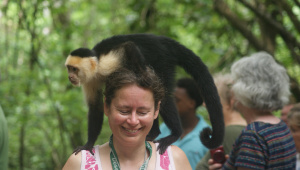
The monkey was climbing all over my hair.
Then it was back to the ship.
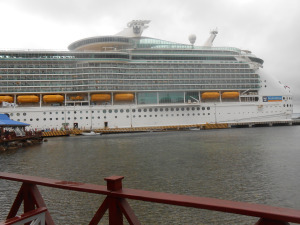
See that first gangplank? The porthole directly above it was my stateroom. You might need to enlarge the photo to see it.
Filed under: Photos, Travel Tagged: Desert Storm Reunion, Honduras








November 4, 2015
Desert Storm Reunion – Day 4 – Belize
First up, a picture of the Chihuahua from Mexico, since Pagdan asked about it:
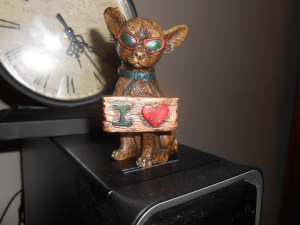
A dog with an attitude
On Wednesday, we arrived at Belize, right on time. I got up at my usual time, but it was still early for the Windjammer to open, so I explored. This time I went up to Deck 12, which was an open deck with deck chairs. If there were stairs I could climb up, I went up them, though much higher and I was ready to come down right away (I’m afraid of heights).
It was also very windy away. It didn’t blow in gusts that paused, but a steady stream.
Belize’s port was too small for our big ship, so we moored five miles out, which is called tendering. Belize port authorities brought a tug boat and pulled it alongside the Navigator of the Seas. The crew set up the gangplank to the tugboat, which would stay there all day, and then the tendering ships pulled in alongside.
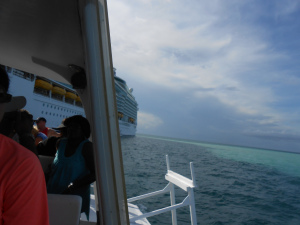
Leaving the cruise ship behind …
We piled into a tendering ship and made the trip in. We were warned of the last tender of the day and to not wait until that one.
We lined up on the dock, and of course, when the opportunity to use the bathroom presented itself, all the women veterans headed over. Women soldiers learned quickly to go when there was an opportunity, not when they actually had to go. We had hand sanitizer, so we opted to use that instead of the water.
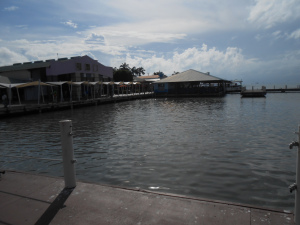
This is where we picked up the tour.
My excursion today was a trip to the Belize Zoo. It had been a challenge picking a lot of the excursions in general; many of them were called “strenuous” and involved doing things I wouldn’t have even done when I was 20, like zip lines. I had to read reviews and study the facts about the trip to see if my feet would handle it. Though ruins turned up on the excursions, they had uneven ground—one of the other vets reported how hard one of the Mexican ruins had been the day before, and that was rated as intermediate.
The Belize Zoo had some walking, but was also in a boat, and it was good for the disabled. We started out with the boat, which was a large power-boat. What no one told us was that we should have brought bottled water. The temperature heated up so much that that I was sweating off the sunblock.
We roared up a river, the wind the only air conditioning. The first part of this excursion was a 90-minute tour of the river to see the animals in the trees. One of the guides stood on the bow and spotted the animals.
By the time we got to our stopping point, it was lunch time and I was about melted. Lunch was typical Belize fare, according to our guides: chicken with sauce; beans and rice; lettuce. It was pretty good, too. I bought a soda and two bottles of water.
Then it was off on a drive to the zoo, so I got to look at the houses in the area. Most of the houses had a sort of unfinished look. We were told this was because if the house is finished, then it gets taxed, so everyone left it unfinished. Most of the houses were one story, and had laundry hanging on the railing. Some were on stilts—not because of flooding but to keep the snakes out.
The Belize Zoo is the smallest zoo in the world, but also only has animals that are from the area. If you go there on a tour, take school supplies. One of the women vets, Lila, had been a substitute teacher, so she brought tons of supplies. The zoo attendant was like “You mean we get to keep the backpacks, too?”
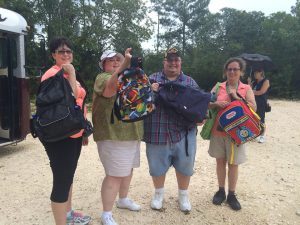
R to L: Lila, a veteran I will be telling a tall and true tale about; Darryl, a chaplain, and his wife (sorry, I don’t remember her name); and me. All this was what Lila brought.
Then it was off to see the animals. The guide warned us that if we saw him running, then that was a good idea. The fencing for the animals was not a great challenge for them. He noted that the animals wanted to stay there because of their circumstances, so they usually didn’t try to escape. Many of them had been pets or mistreated; one was a bird that had been so socialized with humans that it couldn’t survive in the wild.
The howler monkeys were the big surprise. I kept hearing this strange sound, and it was like some giant monster was nearby, stalking us. It was those monkeys!
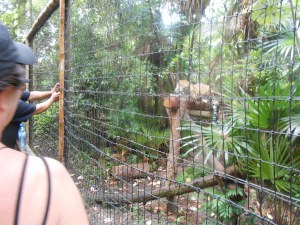
The highlight was this fellow. He posed for us and was magnificent. Enlarge so you can get a good look.
By the time I got back to the dock, I felt really melted from the heat. I could have stopped off to look at all the stores, but I was just done. Besides, it was getting to be late enough that I didn’t want to wait, so I got in line and returned to the ship.
After I returned, I found out where exactly the gangplank was, because I kept hearing beeping from Sea Pass cards and realized that my cabin was directly over the gangplank!
And I found this:
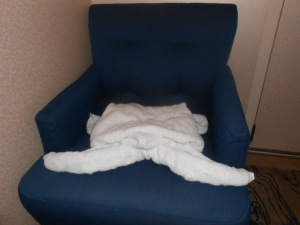
I liked this even better than the rabbit, because I like looking at turtles.
Filed under: Photos, Travel Tagged: Belize, Belize Zoo, Desert Storm Reunion








November 3, 2015
Desert Storm Reunion Day 3 – Cozumel, Mexico
When I woke up on Day 3, we were in Mexico. I’d learned the night before that my sea turtle excursion had been canceled, but it was too late to try to book another excursion, so I decided to do the forum shops.
First stop when I got off the ship was checking out the stores at the dock. These were the touristy ones with all the things that tourists want to buy. I stopped first a drugstore to buy bottled water because it was already hot out and the sun was barely up.
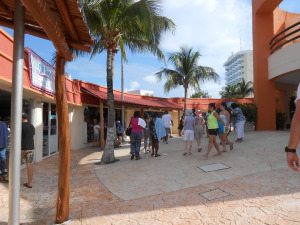
These were the stores right on the dock.
I enjoyed window shopping here, though I got an early taste of what was to come. One of the store owners stood outside and invited me into the store. It sold a lot of the touristy stuff and some jewelry, so I bought my first souvenir, a Mexican Chihuahua..
Then he escorted me over to his cousin’s store, which had a lot more jewelry and followed me around, trying to make the sale on anything I touched. He kept asking if something was wrong because I wasn’t buying any of the jewelry. It was pretty, but I wasn’t buying jewelry of that kind.
He kept hovering, and then all I was doing was looking for an opportunity to leave the store. A couple came in, and I slid out.
I took a cab the two miles down to the forum shops. The forum shops are apparently why a lot of people go to Cozumel. They sell a lot of jewelry very inexpensively, and it’s all duty free. It’s all gold, silver, turquoise, and jewels, so real jewelry. But the stores were all kind of run down.
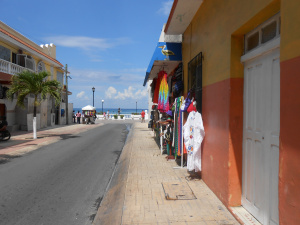
This is a side street at the forum stores. I was surprised that I didn’t get any shots of the stores themselves.
Like at the earlier place, the store owners stood outside and pulled me in, then hovered. They were puzzled as to why I didn’t seem interested in anything, and it was because any time I touched something, they jumped up like it was a call to buy now.
The worst was going into some of the side stores where they did sell things I was more interested in and priced more to my range. This time it was a woman, and she pulled me into the store. By then, I was hating the selling technique, so when she did it, I was even less enamored of buying anything. I finally bought a $5.00 bracelet, but then she wanted a dollar tip and the smallest I had was a $20.
So she dragged me down to a store I had just visited, one that belonged to her cousin. That one sold designer bags, and strangely, though I had been there less than 10 minutes before, the owner did not even remember me. I did not buy anything so she took me to another store (another cousin), and this time I picked a $2 turtle to buy so I get away from this nonsense. The cousin couldn’t break the twenty (read: she wanted me to spend more than $2), so the woman finally gave up in disgust.
Escape!
I ignored another man calling to me to come into his store and walked across the street to the white wall that ran along the water. There wasn’t really much access to the water, but there were some beautiful sculptures. I spotted a cab, and decided I was done.
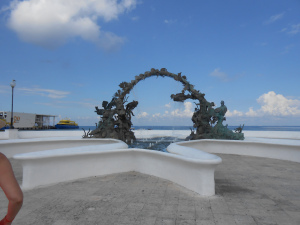
This was a fountain that was across the street from the forum stores.
Definitely if I go to Cozumel again, it will not be anywhere near any stores. It was very unpleasant.
By the time I got back to the ship, the skies had turned black and we got a downpour.
I found that I enjoyed my time on the ship there because no one was there. The energy levels were way down too, and it was so much quieter. I also noticed for the first time the dog greeter at the entrance to the Windjammer, who the crew dressed up for Mexico.
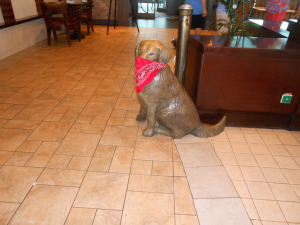
All dressed up for Mexico
Back to the dining room for dinner, though it looked like a lot of people were pooped out from Mexico. Initially I was the only one at the table, so some of the other vets invited me over (then everyone showed up!). Two of the women were nurses, one from Desert Storm and one who had been in Vietnam and Desert Storm. I saw her a lot all over the ship. Like me, she was traveling solo because she’d done all the communal living in the military and didn’t need to do it now. We ended up in a discussion over post traumatic stress syndrome over dinner (which was the elephant in the room on the cruise).
She said that every war veteran suffers from PTSD, even if it’s only a little bit. I still don’t know what I think of that.
Filed under: Photos, Travel Tagged: Desert Storm Reunion, Mexico








November 2, 2015
Day 2: A Newbie Cruiser
By Day 2, I was starting to wonder if I was going to enjoy the cruise at all. So far, it did not seem fun. I didn’t realize it immediately, but what I had happened was that was getting an overload of energy. I’m an introvert, so I draw my energy from quiet, and a cruise is like getting with the energy of a tidal wave non-stop. I had the same problem during Desert Storm, though it was a lot more gradual, so I didn’t really understand what was happening.
I got up at my usual time, and the Windjammer opened at 7:00 that day. I had to walk through the pool area, which was gorgeous at that time. The pool is open over the top, but the sides are closed off with big sliding glass windows, so I got to see the sunrise at sea.
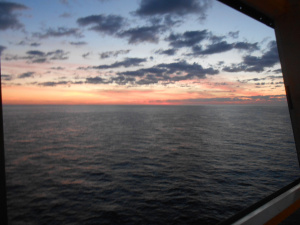
Sunrise from Deck 11, the pool area.
This time I was able to cruise the entire buffet. They had pancakes, waffles, fresh fruit, the usual assortment of egg type products, and usually something international. One of the things that I found and got every day I could was fresh figs. I’d never seen fresh ones before, and they were green, sweet, and soft and squishy.
My feet still ached terribly, compounded by the fact I was wandering. I didn’t realize it at the time, but I was looking for a quiet place to recharge. There isn’t any on a cruise. I did find a spot in one of the bar lounges that was not too bad at that time, so I would read, but people were everywhere all the time. Most of the places on a cruise are designed so people will pass through them. Even the library was an egress to cabins.
My recharging, as much as I could get, ended up being early in the morning until about 9:00 and then again from 3:00 to 5:30, and the periodic rounds on the walkabout deck.
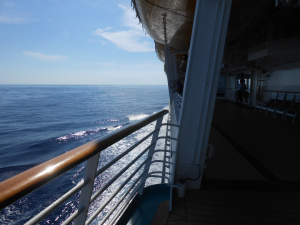
It was always quite windy out on the walkabout deck. I was getting better about being able to go outside without getting dizzy.
First order of business of the day ended up being a session for first time cruisers. Each day, we received a “Cruise Compass,” which was four pages of events and information for the for the day. Many of the events were the kinds of things to get everyone to spend money, like ones from the spa. “Secrets to a Flatter Stomach,” “Wrinkle Remedies,” and “How to Look 10 Years Younger.” There are so many of them it’s hard to take all you want because some conflict with each other.
The first time cruiser was given by a man from Australia, and I’ll admit, I loved listening to the accent. The crew was international, so I got a lot of different ones during the cruise. Some of the things we learned:
There were 3,100 passengers and 1,000 crew on board.
Ship’s time was set by the port we had departed from. No matter what the time was at the locations we went, we were to go by ship’s time so we would get back before departure.
How to navigate around on the ship, which included Entertainment Forward and Food Aft.
That day was also a Champagne Art Auction, the first of three of them. There I met up with two of the other women vets, who were also my table mates at dinner. The champagne was free, so I tried it out since I had never had it before (I don’t drink). It looks beautiful and tastes terrible.
The room was set up with rows of paintings from an international art gallery. It included paintings by Peter Max and Thomas Kincaid, as well as Autumn DeForest. We had half an hour to look before the auction started. It wasn’t like what I pictured an auction where everything was auctioned off. Interested people marked paintings they wanted to see on the auction, and the rest of the paintings that went up were selected by the gallery. There were also raffles for paintings (not worth the $35 appraisal fee) and free prints for attending. One of the women vets won a painting in the raffle, which later turned into an interesting trend.
At about 5:00, I found myself headed up to the spa because my feet were so bad and got a foot and back massage. That helped a lot, also because it was so quiet in the spa room.
Dinner that night was a formal event, so formal wear. I was nervous about this because I didn’t have confidence I would be able to dress to standard. Most of the women were better dressed than the men; one man showed up in a polo shirt. I survived it without anyone noticing my shoes (thank you!).
The kitchen staff now was starting to figure out that it was a challenge leaving milk out—that suggested to me that most people probably opted for the Windjammer rather than ask for dairy free. Dairy free often didn’t mean the meal was dairy free, but that they had to come up with an alternative. At the end of the meal, the waiter brought out a draft copy of the menu so I could mark what I wanted and give the kitchen time to figure out what to do. Of course, that menu got passed around the table so everyone could check out the next day’s meal.
The meals were an event in themselves. I really didn’t want to gain the average weight a cruiser gains (2 pounds a day, so 14 pounds), so I worked at not eating too much. The portions of the courses were generally pretty small compared to if I went to a local restaurant, so this was helpful. Some of my table mates ordered second appetizers, entrees, or tried two different deserts. Escargot was an appetizer on the menu every day, and almost everyone tried it at one point. I did not, partially because it had a cream sauce, but also because … well, snails.
The meal lasted two hours, and then it was 10:00 and my brain was shutting down. I came back to my cabin and discovered my statement room attendant had stopped by to leave something:
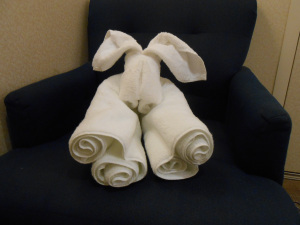
Getting this just made me laugh aloud. It was wonderful and silly and just fun.
Filed under: Photos, Travel Tagged: Art Auctions, Carribean Cruise, Desert Storm Reunion, Navigator of the Seas








November 1, 2015
The door-to-door salesman of developmental marketing
When I was a teenager, we had a visit from a door to door salesman. It actually wasn’t a common thing, partially because of our location, which looked like an alley, and partially for reasons like below.
The salesman was young, very handsome, and very charming. No doubt, he expected to find the woman in the family at home so he could charm her into buying the bottled water he was selling.
He got my father.
That should have told him right away to leave and go onto the next house. My father’s first words were, “We don’t buy door to door.”
That should have also told the salesman to leave. The good ones will, once they realize they’re not going to make the sale. No sense in wasting time. Either this salesman wasn’t good or corporate policy was to be aggressive.
He wouldn’t take no for an answer.
Finally, to get rid of the guy, my father bought the water. Once he closed the door, he went to the phone and called the water company. He cancelled the order and told them why.
So I have a cynical eye when someone asks me for money. Even so, it started out tough as a writer. Much of what I saw early on was marketed to beginners who didn’t have any knowledge and didn’t know what questions to ask.
I subscribed to Writer’s Digest and got put on a mailing list from an agent. He sent me a four-page advertisement for his agency. It was impressive looking. On the first page was pictures of authors the agent represented, none of whom I had read or heard of. Still looked impressive.
It was a sales pitch. The agent said he would look at my manuscript for a reading fee of $500. I didn’t have the money, so I didn’t get taken, but if I had, I would have sent it in. The brochure said all the right things and made me feel special.
Of course, it should have been a warning that I was sent it at all.
Then there’s editing. That’s a big business, where people make a lot of money off beginning writers. When I first got on line, there was a big scam where agents were rejecting writers and referring them to an editing service. Since the agent had referred them and knew what he was doing, the writers trusted this and happily paid for the service. The agent and service counted on the writers not educating themselves and reacting emotionally.
When I was ready to go indie, I didn’t even have to think: I was going for copy editing.
Not developmental editing.
I’ve had writers predict dire results or tell me I was cheapening my writing. I even had a panel at a con try to embarrass me into getting developmental editing. I had shown up for the panel early, and they asked me what goals I had. I told them I was looking for a copy editor. In front of the crowd of people that finally showed him, they admonished me about not going for developmental editing. Granted, most of the panel was developmental editors, so it wasn’t hard dismissing the source.
It bothered me that a whole lot that people had their hand out for potentially thousands of dollars (one I looked at would have charged me two grand for a 40K novel) for developmental editing. It reminded me of that door to door salesman coming to the front door expecting to make the sale on emotion and not facts.
The facts are that developmental editing is essentially paying for an in-depth critique. The person may or may not be qualified to do it. Some writers will look at one or two published books as proof the editor knows what they’re doing. But especially after taking so many writing classes given by writers with that qualification, I found out how little they actually knew. Because I didn’t outline, I often ended up with a front row seat to their lack of craft knowledge.
Besides, why should I pay someone to tell me how to write? Seriously, if I have a weak area, surely the money could be better served to buy craft books on that area, maybe take a really good class (not one of the ones above!), and spend the time working the skill.
That seems like a better investment of my money and time and would give me the most benefit.
Filed under: Opinion, Writing Tagged: Copy Editing, Developmental Editing








Desert Storm Reunion: Day 1 Chaos
Sorry for the delay on this—I’ve spent the last week doing two short stories that were due October 31 (and got both in on time). All that while I still had cruise brain.
I flew to Galveston, Texas on October 10. It’s apparently a major hub for cruise ships. In addition to my ship, the Navigator of the Seas, Carnival Magic was also there (Carnival line). October is a slow time of the year.
My cousin Sonya, who is about what would have been my mother’s age, picked me up at the airport and took me to the hotel. I had an extra day on the backend of the trip so we could visit.
There was a Desert Storm veteran gathering at the hotel I was staying at. I was surprised at the number of people, and the number of women who weren’t wives. I have one annoying moment when I wore my Desert Storm hat down in the elevator and one of the hotel guests asked if my boyfriend or husband was the vet.
Right.
I didn’t know anyone at the gathering, so no one from my unit. I’d be surprised if they would have done a reunion, though. By the time the war ended, everyone despised each other.
One of the veterans would come in very late. He was flying in from Europe, and the airline lost his luggage in New York. By the time he landed at George Bush, he was less than two hours from cruise departure time. Bush is 90 minutes from the docks, so he gave the driver a generous tip and arrived in an hour.
Boarding the Ship
Getting on board was chaos, and yet, not nearly as bad as it could have been (like flying. Ahem). There were some 3,000 people getting on board the ship, and the cruise ship kept it running smoothly. Imagine 3,000 people boarding an airline.
I lugged my suitcase and carry-on into line and stopped at a counter where my passport was checked in. The counter person gave my Sea Pass, which is a multifunction card:
It was pass to get onto the ship. If I had a Sea Pass, it meant that the cruise line had verified my passport. The crew would scan it going on the ship and off, so they could have accountability.
It was the key card to my stateroom.
It was like a credit card. No cash was carried on the ship, which probably cut down on that. We just used the card to, say, pay for ice cream.
After my Sea Pass card was duly scanned in at the gangplank, I wheeled all my luggage on board and tried not to whack anyone with it. My stateroom was on Deck 2, which turned out not to be that easy to find. The ice rink cut off Decks 2 and 3, so they were the only ones that didn’t go all the way through the ship. I actually had to go up to Deck 4, go aft, and then go down to Deck 2.
At last I found my stateroom.
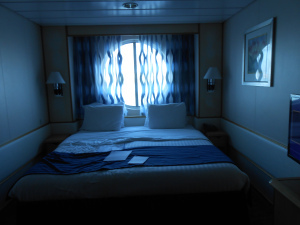
My stateroom on Deck 2. This sat pretty close to the water.
It was pretty small, though the shower was even smaller. It was like a torpedo tube. There were some pretty heavy people on the cruise—I don’t know how they took showers. It was small enough that it was a little too close for me.
Suitcase down, lunch next. With all the check in and trying to find my stateroom, it had taken a while. It was almost 2:00. I consulted the directory next to the elevator and headed up to the Windjammer Café on Deck 12.
The Windjammer was a buffet. The food was free, but if I wanted sodas or booze, I had to pay for a drink package. In my case, I purchased a soda package. All I had to do was show the Sea Pass card, which had a Coca-Cola logo in the corner to get my soda.
I was so hungry at that point that I hit the first line I saw, grabbed a glass of water, and ate. I found out later a lot of the other veterans did the same thing. Exploring the buffet more came the next morning. The Windjammer had these big windows all around, so I had a good view of Galveston.
After that, more exploring. I kept getting lost, so I did a lot more walking that I probably should have. Because my feet a “poorly constructed” as my podiatrist says, they really hurt and ached. But it was fun to walk around because the cruise ship wasn’t like a big hotel. It was meant to entertain everywhere, in some way.
At the landing for every set of stairs, there were two paintings and two glassed in sculptures. Not hotel art bought in bulk, but actual original art the cruise line picked (and for sale).
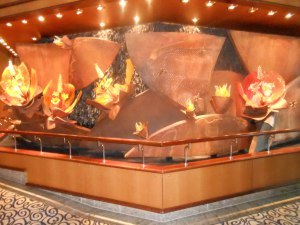
This is a sculpture that was in one of the bars!
Leaving Port
I found the walk about deck, which circles most of the ship. I could walk around it and see the water.
I was out there when the ship started to move. I watched Galveston get left behind, but I couldn’t stay out there very long. Watching the water made me dizzy, and for a while I was aware of our movement.
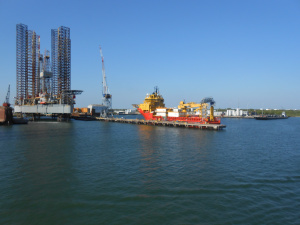
This is a view of Galveston from the ship as we headed out to see. A lot of oil refineries.
Then it was off to the Promenade. Most of my association with that was hearing it on The Love Boat.. The Promenade was like a giant mall. It was where all the stores were, and the 24-hour snack place.
One of the events of the cruise on the first day was a circus parade. The crew quite efficiently unrolled a blue cloth tape and roped off the crowds on the edges.
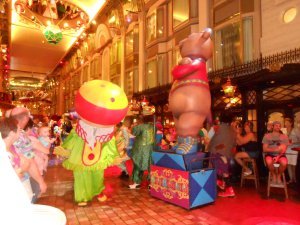
It was hard getting photos of the parade because it just moved so fast. By the time my camera snapped the picture, the performers had already danced past.
The parade was chaos in itself–a lot of brightly colored costumes whirring past. But it was a lot of fun, and it looked like the performers had fun.
Dinner
Dinner was in the dining room, and 8:00 seating. This was hard for me, because dinner was so late. I would end up getting a snack during the cruise at about 4-5 to tie me over until dinner. The times were picked by the reunion committee, so it was what it was.
The cruise had put all the Desert Storm veterans together on one end of the room. We were assigned tables (on the all purpose Sea pass card).
I was surprised to see that the menu offered dairy-free (also gluten free). I’m lactose intolerant—I can have cheese, but not milk or yogurt. Unfortunately, though the menu said dairy-free, that did become a problem. I think most people probably went to the Windjammer instead because you could pick your food. The kitchen seemed pretty unprepared for actually dealing with it.
The kitchen gamely tried to work around the dairy issue without complaint, though when I did a survey for the cruise, I did comment that the menu really needed to have one item that didn’t have milk. Most of the time, the kitchen was having to make adjustments, rather than just serve the meal. Also that they shouldn’t call Caesar Salad dairy free because that turned it into lettuce and tomatoes.
The meal was three courses: a small appetizer, the main course, and desert. Despite the late time and the problems with the milk, I went to all of them. It was one of the few times all the veterans got together, and also, the food was really good.
By the time the meal ended, it was 10:00 and time for bed!
Filed under: Personal, Photos, Travel Tagged: Carribean Cruise, Desert Storm Reunion, Navigator of the Seas, Photos








October 24, 2015
Desert Storm Reunion Cruise: The Insanity of Getting Ready
October marks the 25th anniversary of when I deployed to Desert Storm. My company deployed from then Fort Lewis, Washington, to Saudi Arabia on October 28, 1990. This month also was the 25th Anniversary Reunion Cruise in the Caribbean.
For the months leading up to the cruise, I had a surprising amount of anxiety about it, because some really not so good things happened during the war. People put under so much stress show who they truly are, and sometimes that’s not a good thing. I had a friend who self-destructed under the pressures of war, and all I could was watch as it happened.
One of the things I’ve heard over and over is people asking, “Why don’t you talk about the war?” to veterans, not really understanding what the veteran is hearing. I think they’re asking “What was it like?”—which is why I wrote Soldier, Storyteller.
What the veteran is hearing is that they have to tell some of the stories—and all of us have at least one—where things got beyond bad. I don’t think it’s something where you can really talk about it and “get over it,” because it’s so far off the end of the scale of comprehension.
So going into the cruise, I kept wondering how touching this part of my past was going to affect me.
The pieces sort of started coming together once I got my passport. It was off to the travel clinic to get shots (you can tell Washington, DC has a lot of overseas travel. We actually have a travel clinic at a local hospital!). I got a typhoid shot and one for hepatitis. Target was having a good time of it because I had a prescription for malaria medication, which must be a bit odd!
The cruise had a way of getting people talking. I was telling the pharmacist at Target about it, because he’d never been, and afterward, he was thinking of going.
After that, addressing the formal wear. We had two formal nights on the cruise, and I didn’t know what to expect. I’ve never done formal wear before, so it was highly likely that I wouldn’t get it right. I’ve always had a problem with dressing up because when I was growing up, my main source of clothes was hand me downs from my aunt and the thrift shop (on my own allowance). We weren’t poor, but rather the person who did the driving had a very skewed view of shopping. He thought that you should be able to walk into a store like a surgical procedure: Pick the clothes off the shelf and buy them. Otherwise, he didn’t want anything to do with it.
Yeah, try that with women’s clothes where none of the sizing is standardized.
Because of my flat feet, I also can’t wear any heels—do you realize that leaves out about 99% of women’s shoes of all kinds? I had visions of being turned away like the women at the awards ceremony, who wore flats with their elegant gowns. I was going to be wearing sandals that looked like tennis shoes.
I found cocktail pants that were in chiffon, some silver jewelry, and used a blouse I already had. I figured they’d hide the shoes. I saw comments on blogs that the cruise ship staffs have turned people away, but try not to unless it’s too much too casual.
I packed two bags, one standard suitcase and a small carry on. Then it was off to Galveston, Texas for the first day of the reunion, and the first cruise ship sighting:
Filed under: Military, Travel Tagged: Desert Storm Reunion, Galveston, Navigator of the Seas, Texas









